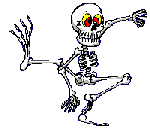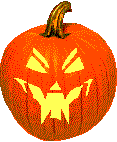
Or so they say in the movies, anyhow. Yet, on Halloween, there's
an awful lot of ghosts and goblins and vampires and werewolves
and mummies...*shudder* (scared myself). I ran across some history
on Halloween and thought ya'll out there would like to take a
look at it...
![]()

For most cultures, the beginning of the Autumn season spawns
a time of reflection about those who have passed away. In Northern
Britain, the words ghost and guest (geist) are the same word.
In isolated and mountainous Celtic villages, dead relatives were
dug up and their skulls reverently painted, so they could rejoin
the family during October "dumb" feasts. With little
space to spare for burial, these skulls would be stacked and saved
for future festivals in eerie rooms. Gives a new meaning to ancestors
watching over you, doesn't it?

Some cultures celebrate the end of harvest with a nighttime
wander to either welcome or frighten away roving spirits, while
some festivals include door-to-door begging to benefit children
and the poor. Mexico's "Day of the Dead" on November
2nd combines honoring the dead - by tidying graveyards and offering
food to ancestors - with the playful and macabre appearances of
sugar skulls and paper mache skeletons. In the United States,
the Celts celebrate with divinations and communication with the
spirit world; while American Halloween activities, brought from
the British Isles, focus on parties and nighttime mischief, evolving
only during the early 1900s into "trick or treating."

In Germanic Pagan tradition, taxes and wages were collected
in person at this time of year. In Scotland, this practice turned
into playful door-to-door begging called "guising."
The ancient art of communing with the spiritworld evolved into
"soulling" in England: wondering about at night, disguised,
welcoming the ancestors back with lights held in carved out turnips.
Later, with the rise of the church, seeking contact with the other
side was discouraged, and folks attempted to frighten ghosts away.
In America, successive waves of European immigrants in the 1800s
diluted British traditions, and when nighttime mischief-making
began to be practiced by the newcomers, it fueled native prejudices
and fears of juvenile delinquency.

By the turn of the century, Halloween had become an ever more
destructive way to "let off steam" for crowded and poor
urban dwellers. As Stuart Schneider writes in Halloween in
America (1995), vandalism which had once been limited to tipping
outhouses, removing gates, soaping windows and switching shop
signs, by the 1920s had become quite nasty - involving but not
limited to real destruction of property and cruelty to animals
and people. Also, the disguised nighttime terrorism and murders
by the Ku Klux Klan reached their apex during the decade. Schneider
writes that neighborhood committees and local city clubs such
as the Boy Scouts then mobilized to organize safe and fun alternatives
to vandalism. School posters of the time period call for a "Sane
Halloween." Good children were encouraged to go door-to-door
and receive treats from homes and shop owners, thereby keeping
troublemakers away. By the 1930s, these "beggar's nights"
were enormously popular and being practiced nationwide, with the
"trick or treat" greeting widespread from the late 1930s
to present day.
![]()
Social changes during the last 30 years have mutated Halloween's
innocence. During the 1960s, the rise in cults, the Manson murders,
and movies such as Rosemary's Baby and The Exorcist
fleshed out satan's biblical character. The popular culture's
expression of satan gave life to it: literally invested it with
the fear of evil, where there was little previously. Hollywood
created the satanic cult, and he is alive and well there.
The well-publicized acts of loading brownies with pot or LSD
by a few idiots during the '60s insured that Halloween treats
are now exclusively pre-packaged, store brought candy. Most homemade
treats are tossed unilaterally. Later, scares of candy loaded
with pins or razor blades further lent sinister possibilities
to Halloween, making hospital emergency x-ray rooms the last stop
on Halloween night for many trick-or-treaters. Ironically, most
Halloween decorations and paper products today are benign and
fluffy cute, while "acceptable" scary entertainment
features large scale bloodbaths. Michael Meyers, Jason, and Freddie
Kreuger hang out on all the channels. Mystical spirits and ghosts
are gone from the scene, considered too tame by the media.

Yet Halloween survives as an exciting part of the harvest season.
Perhaps we will learn to overcome every-day threats and dangers,
leaving alone traditions that make childhood magical, and restoring
the mystical freedom and connection to community that Halloween
has come to express. One may always hope.
![]()